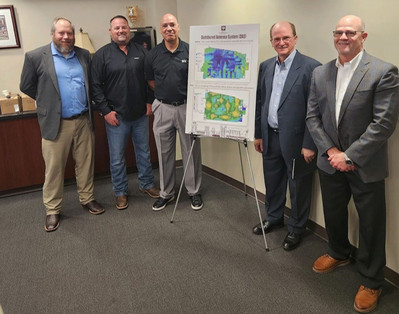March 4, 2024

Network Improvements Continue for Texas A&M
Texas A&M University is in the third year of a multi-million-dollar project to modernize the main campus with 6E wireless technology and transform the digital experience for students, faculty, staff and visitors. The Next-Generation Aggie Network, or the Next-Gen Aggie Network for short, aims to provide faster, more consistent and reliable internet access across the university’s 5,200-acre main campus and Texas A&M University Health Science Center’s Bryan campus. This unique venture further elevates the Next-Gen Aggie Network project as a competitive advantage, making Texas A&M a leader in network innovation for academia.
The project will extend Wi-Fi coverage in high-traffic outdoor areas and provide better support for data-intensive research efforts. To date, significant progress has been made in preparing for the launch of the network, such as installing new fiber, identifying wireless access points for upgrades and increasing the number of access points, upgrading network switches and overall maintenance on the expanded network.
“The scale and scope of the project is hard to fathom. Every cable, network port, user computer and Wi-Fi access port is affected by this project,” said Rob Gatlin, Technology Services network engineer. “No other university, to my knowledge, has completed a project of this size. We are completely rebuilding networks for four to five buildings every two weeks, which requires a huge effort by all teams to coordinate and implement.”
The multi-year project is expected to be completed by 2026, with phase three now underway. The project team will continue to install access points by zones and focus on boosting wireless coverage in needed areas identified through surveys. The Sterling C. Evans Library, the Memorial Student Center and Rudder Tower will be undergoing additions in spring 2024. The Next-Gen Aggie Network project is a collaborative effort among Technology Services, Facilities and Energy Services and other campus partners.
A new distributed antenna system for Texas A&M Health
A separate project focusing on cellular service, a cellular distributed antenna system (DAS) was recently installed at Texas A&M Health’s Bryan campus. Texas A&M Health approached Technology Services about a cellular solution for staff, faculty and students at their facility on Highway 47. At the time, there was limited cellular service in the building. Employees, students and visitors were having difficulties completing their daily tasks while on site and it was hindering productivity.
After investigating possible solutions, Technology Services created a DAS that brings commercial cellular signals inside buildings. It consists of mounted antennas that broadcast cellular signals. Verizon partnered with the university’s network engineers in the first phase of the project and this installation is complete. AT&T has completed their equipment installation and is in the final stages of optimizing their network. T-Mobile should be installed by the summer.
This solution will allow faculty, staff and students to send and receive texts, conduct voice calls, and download and upload their data using cell signals. Built with growth in mind, this state-of-the-art system is already set up to facilitate future upgrades, allowing the network to serve 5G with minimal effort.
DAS Network Coverage — Before Optimization — Health Professions Education Building

DAS Projected Network Coverage — After Optimization — Health Professions Education Building

An event took place on Monday, Feb. 26 at the Texas A&M Health campus in Bryan to celebrate the completion of the first phase of the DAS project. Partners from Cloud Ingenuity, AFL, Commscope, Verizon Wireless and AT&T joined, as well as executive leadership from Texas A&M Health and Technology Services.
Technology Services and Verizon Wireless personnel took part in the recent Texas A&M Health event. From left to right: Dan Schmiedt, associate vice president for networking and telecommunications at Texas A&M; Jeremy Rice, Verizon Wireless senior engineer in-building and small cell construction; Corrie Poole, Verizon Wireless associate director of network construction; Ed Pierson, chief information officer and vice president for Technology Services at Texas A&M; and Nash Higgins, 5G architect at Texas A&M.
Main campus private network expansion
A private cellular network, the TAMU Private Cellular Wireless Network (TPCWN), was recently designed and constructed around Reed Arena and the surrounding area on West Campus. The network will continue to grow to cover the main campus over the next two to three years. It is designed and constructed to support both 4G and 5G technology, setting the stage for future generations of technology.
Transportation Services is using TPCWN to connect buses to the Texas A&M network to reliably transport data to and from buses as they move. This network also allows effective parking lot management for services like scanning parking passes, taking payments, etc. It also eliminates the need for Transportation Services to set up and tear down temporary Wi-Fi networks on home gamedays, creating cost savings for Transportation Services. This distinctive endeavor in academia further positions Texas A&M to demonstrate significant leadership in academic and operational private cellular network technology.
Faculty, staff, students and visitors will enjoy a faster, more reliable digital experience at this innovative institution through the completion of these network improvement projects.